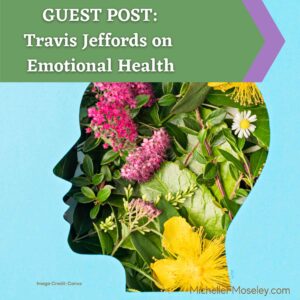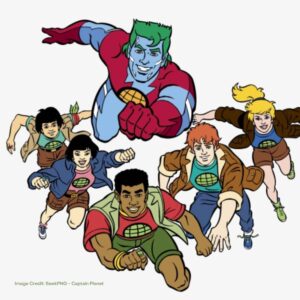I’m excited to share a guest post written by my friend and colleague, Travis Jeffords, on the topic of emotional health of individuals and within groups. Travis Jeffords is a Licensed Clinical Mental Health Counselor Associate in North Carolina, and also holds a Master of Divinity from Christian Theological Seminary. Travis writes on the intersection of faith, spirituality, the church, and mental health.

Characteristics of Emotionally Health Groups, and Emotionally Healthy Individuals by Travis Jeffords
There was an animated T.V. show that was on saturday mornings when I was growing up called The Smurfs. All the Smurfs (with two exceptions) looked exactly the same: short blue bodies, same blue faces, matching white caps, and matching white pants and shoes.
There was one smurf named Papa Smurf who wore red, and one female Smurf, named Smurfette, who had long blonde hair. Other than that, they were basically all the same, if I remember correctly. They all smiled and sang happy songs together and seemed to get along perfectly well! I have to admit it was a very comforting show to watch when I was 4 or 5 years old!
I’m convinced that for most people, when they think of their ideal family, or church, or job, or community, they imagine something pretty similar to the smurfs … everyone looking the same, and thinking the same, and smiling, and singing happy songs, and getting along together.

But, as it turns out, while that dream of perfect sameness may be appropriate for a 4 or 5 year old child’s cartoon, it ends up being pretty terrible for communities made up of real live people … because … well, we’re just not all the same!
Murray Bowen’s Family Systems Theory
Psychiatrist Murray Bowen discovered in the 1950s that people in groups or systems (families, churches, workplace, etc.) naturally have two competing drives: the drive for togetherness … but also, the drive for individuality. These two drives naturally coexist in the system, and in a healthy system are held in balance with one another.
In a healthy system for example, there is some sense of togetherness – maybe shared commitment to each other, maybe shared dreams about the future, maybe shared history and stories, but there’s also space where individuality is respected, honored, and appreciated.
People can be in the group, but also be free to be unique and differ from other members.
People who have spent time in unhealthy, toxic, or traumatic families or religious communities however, have often experienced a different kind of system … one in which togetherness was valued above all else, and there was no room for, or tolerance of, individuality. People in these systems are often required to think exactly the same, and hold exactly the same political values. Oftentimes bodies and sexuality and expression of emotions are also rigidly controlled in an effort to maintain this togetherness in the community.
In real life, these families and communities are definitely not like the happy, smiling, singing Smurfs I saw on T.V. in the late 80’s. In overt, as well as subtle ways, these groups communicate that conformity, and togetherness is the only desire group members are allowed to express, and that any desire for, or expression of individuality is wrong.
The problem is … while Smurfs may be literal carbon copy versions of one another where the artist just traced the exact same face over and over again, humans are most definitely not that way. We have within us a natural drive for individuality that needs to be expressed (as Bowen found). Unlike Smurfs, we’re just not all the same … and that’s a good thing!
In our heart of hearts, we want to be connected with others, but also free to be ourselves and affirmed as our true selves.
In other groups, there is so much individuality, and so little togetherness, that the group is almost not a group at all. Families can be living under the same roof, but basically be like ships passing in the night … they don’t share meals together, or really know anything about each other, and are therefore unable to offer the sense of support that the group, and individuals in the group need to thrive. It can seem like the family are more like a house full of cats instead of a house full of humans … they’re in the same place, but they really couldn’t care less, in any meaningful way, about each other. The result of this extreme individuality can be a kind of emotional disconnection that rarely ends well for the group or family. Children in these families may grow up and think, ‘I wasn’t physically abused, and I had food and a roof over my head … so I guess there was nothing to be upset about.’ But, the truth is, we do have other needs … the need to belong and to be valued and cared for as a member of a group is an important need that we all have. When we don’t get that in groups growing up, it hurts! Even if we can’t articulate what is happening at the time, oftentimes we can intuitively sense that something just hurts inside of us … something isn’t right.
Again, a healthy group/family/church/community values and honors the need of others to express their individuality, and sees individuality and diversity as a gift and strength to the entire community. They have a healthy sense of togetherness, and individuality.
Captain Planet
Another one of my favorite Saturday morning cartoons growing up was Captain Planet.
A group of teens known as the Planeteers would band together in order to fight eco-villains who were endangering the planet. There was definitely a sense of togetherness among the Planeteers – they had a shared commitment and value to defend the planet and educate others about environmental destruction, and they even wore t-shirts that had the same logo on them. But, there was also a sense of individuality, in which their unique gifts were honored and valued by the group. Each of the planeteers came from a different country, and each had their own special power:
- Kwami came from Africa and controlled the earth
- Wheeler came from Brooklyn (way before it was cool) and controlled fire
- Linka came from the Soviet Union and controlled the wind
- Gi came from Asia and controlled the water
- Ma-Ti came from Brazil and wielded the power of heart

To me, this is a really beautiful vision of a community – working for something beyond themselves (the betterment of the planet and eco-justice), while also valuing individual members’ culture, origins, personality, differences, and gifts..
4 Ways We Survive in Communities with Too Much Togetherness
There are a lot of ways of dealing with living in a group that has too much togetherness at the expense of a healthy sense of individuality, and many of them are what Bowen would call “emotionally reactive.”
Emotional reactivity is, according to me, anything we do that keeps us out of vulnerable authentic connection with ourselves and others.
A lot of time it simply doesn’t feel safe to be in vulnerable authentic relationships in the groups we’re a part of, so we find other ways of coping. It totally makes sense! And these are probably the best options that many people have at their disposal at the time!
The 4 main ways we survive in communities with too much togetherness and where our own individuality is not allowed are:
- Compliance – Learning to go along with whatever we’re asked to do, and become whatever we’re asked to become. We sacrifice our own self in order to not upset the group.
- Rebelliousness – Rebelliousness is all about pushing against the socially accepted norms and beliefs of a group in a way that is has more to do with expressing your own individuality and defiance from the group (ie. ‘they can’t control me!’ Or ‘they can’t make me!’), than about really expressing your true value/beliefs/self in a non-reactive way. Here the issue is that we’re still not acting out of authentic vulnerability, we’re emotionally reacting to the group.
- Power struggles – When our own individuality is not respected, we can often begin to criticize, challenge, confront, or argue with others to try to gain the individuality the group is not affording us.
- Distancing – We physically leave the group altogether, because the emotional tension of staying in the group is simply too much for us to know how to handle.
Again – these are not necessarily bad or wrong strategies … they’re probably the best or only options we feel like we have available to us at the time! (I go into a little more detail about these 4 ways we emotionally react in an article here if you’re interested)
But – these are not strategies that we ideally utilize for the rest of our life as our default way of interacting in groups.
One frequent problem is even if we leave or distance ourselves from an unhealthy, toxic, or traumatic family/church/community, our pattern of emotional reactivity is still the same.
We may find ourselves in new relationships, or new jobs, or new faith groups and realize we’re still enacting those emotionally reactive patterns!
We’re still complying, rebelling, engaging in power struggles, or distancing from others in the same way, and it’s no longer serving us.
Or even worse, we may find that we keep jumping from one group/relationship to the next that looks different on the outside, but functions similarly once we’re in it to the groups we were a part of in the past. For example, we may leave a hyper conservative church that demanded too much togetherness from its members, only to find ourselves in a group of liberal political activists that demands too much togetherness too! The ethics, politics, and moral values of the communities we’re a part of may be different, but the group dynamics remain the same.
As my mentor once said, “we don’t run toward what’s healthy for us, we run to what’s familiar to us”.
Self-Differentiation
So .. what do we do if we may struggle with emotional reactivity (and we all do to some extent). How do we find ways that we can exist with integrity and wholeness in the midst of being in a group?
Along with emotional reactivity, Murray Bowen had another term called self-differentiation.
My own definition of self-differentiation is something like this – being calm, curious, and open in a tense emotional system, while also honoring your own values and truth.
Working towards self-differentiation is work that all humans have to do, but especially those who have been wounded by unhealthy or toxic groups/families/churches in the past.
If you’re wondering, what does that even mean or look like to be self-differentiated … here are 7 signs that of acting in a self-differentiated way in a group:
1) Being able to differentiate between a feeling and a thought, and utilizing both
2) Giving up illusions about how a group or others are supposed to act
3) Not trying to control others passively or actively
4) Can face criticism or approval and remain emotionally grounded
5) Act out of a deep sense of your own carefully considered convictions
6) Focus on you in relationship rather than others
7) Remaining calm, curious, and open in an emotional group
If you’ve read through that list and are thinking ‘yeah, I’ve got a few things to work on’…welcome to the human experience! (You can find a more in depth post on these 7 signs on my blog here)
‘Doing the Work’
So, if you’ve read this far you may be wondering, ‘great…where do I go from here?’
The good news is that real change and growth is possible, and there’s not just one way to do it.
Trained, licensed counselors each have their own preferred styles and treatment modalities that they tend to draw from, but there are so many different ways to move towards inner healing and growth, and to increase the ability to be with others in a way where you can be open to hearing them, while also being true to yourself.
Thank you, Travis, for sharing more about what emotional health can look like on both an individual level and within the groups we find ourselves.
Readers, if you resonate with Travis’ voice and perspective in this post, and are seeking counseling in the state of North Carolina, you can connect with him here. And if you’re interested in reading more on Travis’ blog about mental health, you can find it here.
Michelle F. Moseley is a Licensed Mental Health Counselor in NC and a Registered Telehealth Provider in FL. She believes ALL people deserve respect, compassion, and access to mental and physical healthcare. Michelle specializes in working with survivors of religious trauma and with those who have body image concerns, finding there is frequent overlap in these areas. You can learn more about Michelle by visiting her website at MichelleFMoseley.com or following her on Instagram – @therapy_with_michelle
